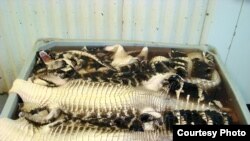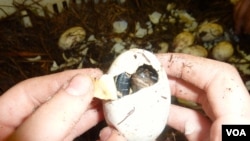CAMILLA, GEORGIA —
When Georgia chicken farmer Mark Glass first started feeding his dead birds to alligators as a way of disposing of them, he didn't realize he was tapping into an industry that would soon have Europe's top fashion houses knocking at his door.
Glass still raises chickens on his farm in Camilla, about a four-hour drive southwest of Georgia’s capital, Atlanta, but powerful predatory reptiles are now his main business.
"We’ve got about 20 chicken houses," he says, "and we’ve got about 100,000 alligators on the farm."
Today, Glass runs one of the largest alligator farms in the country, supplying an industry that covets the animals' hides.
Getting started
Glass was raising chickens, and thought the gators would help solve a problem faced by all poultry farmers - disposing of dead birds.
Normally, about five percent of a chicken farmer's flock dies before getting to market. Most farmers burn or bury the birds. Glass burned his, but propane fuel was getting expensive.
"So we started experimenting with alligators to feed the mortality from the poultry farm to the alligator farm," he says. "I don’t know of anybody that was doing it at the time on chicken farms."
He bought about 750 baby alligators and released them into his fenced outdoor pond and then realized that was not the best plan.
"I finally went and picked up an alligator and carried him to the fence, and he walked right through the fence, and I was like ‘Oh no, these alligators aren’t as big as I thought they were,’" Glass says. "We had to quickly get all the hardware stores in town to open and we bought all the chicken wire that existed so we could make sure we could keep all the alligators in the pond. We didn’t lose but one or two, probably."
New business plan
As the alligators grew, Glass had to rethink his plans. Raising alligators took lots of time, and they needed more than dead chickens to eat. So he began raising them commercially - for their hides and meat.
Alligators don’t breed readily in captivity. So, each summer, Glass collects wild alligator eggs from marshes in nearby states and brings them back to the farm. Such egg collections are legal since the once-endangered wild alligator is now plentiful.
The eggs are placed in incubators where the temperatures are set at 88 degrees Fahrenheit [31 Celsius] with 95 percent humidity. Before long, the alligators begin hatching.
A black and yellow, striped alligator - about 12 centimeters long from head to tail - scurries across the floor. Glass picks him up
"Yeah, that’s one that just hatched," he says, "that’s him barking."
Unblemished skin
Even with 100,000 alligators, the farm is surprisingly quiet. There are no thrashing tails or splashing water. All of the alligators are now raised indoors.
"Outdoors, we were subject to weather, they were much more aggressive outside, much more willing to bite and fight," Glass says.
And when alligators fight, it’s bad for business.
"The industry we are selling the alligator hides into - the Louis Vittons, the Hermes, the Gucci, Prada, Chanel - they want perfect premium skins," Glass says. "No scars, no blemishes, no scratches. And in order to do that, and to maintain the health of the alligators, you really needed to be able to control everything."
So Glass’ alligators live in shallow enclosed ponds, heated to a warm 30 degrees Celsius so the reptiles aren’t induced to hibernate. Several times a day, a farmhand opens a small door and quickly shovels food onto a platform floating on the pond. The alligators eat a high protein diet, as well as a few dead chickens, and as they grow, they’re moved to other ponds, where they spend the rest of their lives.
Handbags and watch straps
Native to the swamps and rivers of the southern United States, the powerful predatory reptiles can grow up to 4.5 meters long and weigh as much as 400 kilograms.
"We grow them to somewhere between 3.5 to 6 feet [1-2 meters] long, depending on what market we’re selling them into," Glass says. "The small hides are 3-and-a-half to 4 feet [1-1 1/4 meters]…and they go into the watchstrap market for the high-end watches. The 5-and-a-half to six footers go into the women’s handbag market."
It takes a year for an alligator to grow big enough to make watchstraps. A handbag needs three two-meter long alligators, and that takes three years.
After the animals are slaughtered, their skins are carefully trimmed and dried on the farm, then graded and shipped to tanneries in Europe and Asia where they’re processed, dyed, polished, cut and sewn into luxury fashion products.
Looking at these leathery-skinned prehistoric reptiles swimming around in a smelly pond, it’s hard to imagine that they’ll end up adorning the arms of the world’s beautiful people.
Glass admits he never thought he’d be in this business. But perhaps he should have had a premonition when 20 years ago, he proposed to his wife at a Florida vacation spot called Alligator Point.
Glass still raises chickens on his farm in Camilla, about a four-hour drive southwest of Georgia’s capital, Atlanta, but powerful predatory reptiles are now his main business.
"We’ve got about 20 chicken houses," he says, "and we’ve got about 100,000 alligators on the farm."
Today, Glass runs one of the largest alligator farms in the country, supplying an industry that covets the animals' hides.
Getting started
Glass was raising chickens, and thought the gators would help solve a problem faced by all poultry farmers - disposing of dead birds.
Normally, about five percent of a chicken farmer's flock dies before getting to market. Most farmers burn or bury the birds. Glass burned his, but propane fuel was getting expensive.
"So we started experimenting with alligators to feed the mortality from the poultry farm to the alligator farm," he says. "I don’t know of anybody that was doing it at the time on chicken farms."
He bought about 750 baby alligators and released them into his fenced outdoor pond and then realized that was not the best plan.
"I finally went and picked up an alligator and carried him to the fence, and he walked right through the fence, and I was like ‘Oh no, these alligators aren’t as big as I thought they were,’" Glass says. "We had to quickly get all the hardware stores in town to open and we bought all the chicken wire that existed so we could make sure we could keep all the alligators in the pond. We didn’t lose but one or two, probably."
New business plan
As the alligators grew, Glass had to rethink his plans. Raising alligators took lots of time, and they needed more than dead chickens to eat. So he began raising them commercially - for their hides and meat.
Alligators don’t breed readily in captivity. So, each summer, Glass collects wild alligator eggs from marshes in nearby states and brings them back to the farm. Such egg collections are legal since the once-endangered wild alligator is now plentiful.
The eggs are placed in incubators where the temperatures are set at 88 degrees Fahrenheit [31 Celsius] with 95 percent humidity. Before long, the alligators begin hatching.
A black and yellow, striped alligator - about 12 centimeters long from head to tail - scurries across the floor. Glass picks him up
"Yeah, that’s one that just hatched," he says, "that’s him barking."
Unblemished skin
Even with 100,000 alligators, the farm is surprisingly quiet. There are no thrashing tails or splashing water. All of the alligators are now raised indoors.
"Outdoors, we were subject to weather, they were much more aggressive outside, much more willing to bite and fight," Glass says.
And when alligators fight, it’s bad for business.
"The industry we are selling the alligator hides into - the Louis Vittons, the Hermes, the Gucci, Prada, Chanel - they want perfect premium skins," Glass says. "No scars, no blemishes, no scratches. And in order to do that, and to maintain the health of the alligators, you really needed to be able to control everything."
So Glass’ alligators live in shallow enclosed ponds, heated to a warm 30 degrees Celsius so the reptiles aren’t induced to hibernate. Several times a day, a farmhand opens a small door and quickly shovels food onto a platform floating on the pond. The alligators eat a high protein diet, as well as a few dead chickens, and as they grow, they’re moved to other ponds, where they spend the rest of their lives.
Handbags and watch straps
Native to the swamps and rivers of the southern United States, the powerful predatory reptiles can grow up to 4.5 meters long and weigh as much as 400 kilograms.
"We grow them to somewhere between 3.5 to 6 feet [1-2 meters] long, depending on what market we’re selling them into," Glass says. "The small hides are 3-and-a-half to 4 feet [1-1 1/4 meters]…and they go into the watchstrap market for the high-end watches. The 5-and-a-half to six footers go into the women’s handbag market."
It takes a year for an alligator to grow big enough to make watchstraps. A handbag needs three two-meter long alligators, and that takes three years.
After the animals are slaughtered, their skins are carefully trimmed and dried on the farm, then graded and shipped to tanneries in Europe and Asia where they’re processed, dyed, polished, cut and sewn into luxury fashion products.
Looking at these leathery-skinned prehistoric reptiles swimming around in a smelly pond, it’s hard to imagine that they’ll end up adorning the arms of the world’s beautiful people.
Glass admits he never thought he’d be in this business. But perhaps he should have had a premonition when 20 years ago, he proposed to his wife at a Florida vacation spot called Alligator Point.







